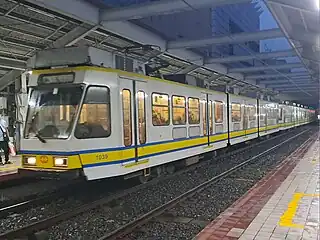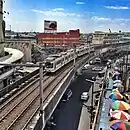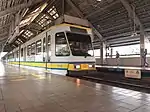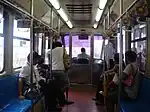| LRTA 1000 class | |
|---|---|
 A 1000 class train at Carriedo station in 2023 | |
 Interior of 1000 class LRV (first refurbishment) with new onboard equipment installed during the 2022 signalling upgrade. | |
| In service | 1984–present |
| Manufacturer | BN Constructions Ferroviaires et Métalliques[lower-alpha 1] Ateliers de Constructions Electriques de Charleroi[lower-alpha 2] |
| Built at | Bruges, Belgium |
| Constructed | 1982–1983 |
| Entered service | December 1, 1984 |
| Refurbished | 1999–2001; 2003–2008; 2016–2017 |
| Scrapped | 2000– |
| Number built | 64 vehicles (32 sets, initially 2-car sets) |
| Number in service | 41 vehicles |
| Number scrapped | 8 vehicles |
| Successor | 13000 class |
| Formation | 2–3 cars per trainset |
| Fleet numbers | 1001–1064 |
| Capacity | 748–1,122 passengers |
| Operators | Meralco Transit Organization (1984–2000) Light Rail Transit Authority (2000–2015) Light Rail Manila Corporation (2015–present) |
| Depots | Baclaran |
| Lines served | LRT Line 1 |
| Specifications | |
| Car body construction | BI sheet |
| Train length | 2-car trainset:59.59 m (195 ft 6+1⁄8 in) 3-car trainset:89.37 m (293 ft 2+1⁄2 in) |
| Car length | 29.79 m (97 ft 8+7⁄8 in)[lower-alpha 3] |
| Width | 2.5 m (8 ft 2+7⁄16 in) |
| Height | Unrefurbished:3.272 m (10 ft 8+7⁄8 in) Refurbished:3.525 m (11 ft 6+3⁄4 in) |
| Floor height | 900 mm (2 ft 11+3⁄8 in) |
| Platform height | 690 mm (2 ft 3+1⁄8 in) |
| Entry | Step |
| Doors | 5 per side; double-leaf swing plug-type; 1,300 mm (4 ft 3 in) wide[lower-alpha 4] |
| Articulated sections | 3 per LRV |
| Wheel diameter | 660 mm (26 in) (new) |
| Wheelbase | Per bogie: 1.9 m (6 ft 2+13⁄16 in) (motor bogies) 1.8 m (5 ft 10+7⁄8 in) (trailer bogies) Bogie centers: 6.75 m (22 ft 1+3⁄4 in) on cab ends 7.5 m (24 ft 7+1⁄4 in) between trailer bogies Total (end-to-end):21 m (68 ft 10+3⁄4 in) |
| Maximum speed | 60 km/h (37 mph) |
| Weight | Unrefurbished:41 t (90,000 lb) Refurbished:46 t (101,000 lb) |
| Axle load | 9 t (20,000 lb) |
| Traction system | ACEC thyristor chopper |
| Traction motors | 2 × ACEC 217.7 kW (291.9 hp) DC series-wound motor |
| Power output | 435.4 kW (583.9 hp) |
| Transmission | Right-angle link drive |
| Acceleration | 1.0 m/s2 (3.28 ft/s2) |
| Deceleration | 1.3 m/s2 (4.27 ft/s2) (service) 2.08 m/s2 (6.82 ft/s2) (emergency) |
| Auxiliaries | Auxiliary converter |
| HVAC | Original: Forced ventilation; 12 units per LRV Refurbished: Air-conditioned; roof-mounted duct type; 5 units per LRV |
| Electric system(s) | 750 V DC overhead wire |
| Current collector(s) | ACEC single-arm pantograph |
| UIC classification | Bo′+2′+2′+Bo′ |
| Wheels driven | 8 out of 16 per LRV |
| Bogies | Inside-frame type |
| Minimum turning radius | 25 m (82 ft 1⁄4 in) |
| Braking system(s) | Dynamic (regenerative and rheostatic) Disc and electromagnetic track brakes |
| Safety system(s) | ATS (1984–2007) ATP (2007–present; for active trains) |
| Coupling system | Semi-permanent |
| Multiple working | Within type |
| Track gauge | 1,435 mm (4 ft 8+1⁄2 in) standard gauge |
| Seating | Longitudinal |
| Notes/references | |
| [1][3][4][2][5][6][7][8][9] | |
The LRTA 1000 class is the first-generation class of high-floor light rail vehicles (LRV) currently operated by the Light Rail Manila Corporation. It first entered service under the Light Rail Transit Authority in 1984.
Purchase

The construction of the original 13.95-kilometer (8.67 mi) section of the LRT Line 1 was funded by a ₱300 million soft and interest-free loan from the Belgian Government. Additional funding for the project was later sourced from a ₱700 million loan provided by the consortium of ACEC (Ateliers de Constructions Electriques de Charleroi), BN (Constructions Ferroviaires et Metalliques, formerly Brugeoise et Nivelles), TEI (Tractionnel Engineering International), and TC (Transurb Consult). The trains were included in the second loan package, along with the power systems, signalling, and telecommunications.[10]
The trains were manufactured by BN (now Bombardier Transportation Belgium S.A.), while the electrical equipment supplied were from ACEC. A total of 64 trains were built between 1982 and 1983.
Design
The LRV design is an 8-axle rigid body consisting of three articulated cars. It is the only 8-axle light rail vehicle in the entire rolling stock of the LRT Line 1, as subsequent trains since 1999 will be built to the 6-axle design of the LRV.
Car body
The LRV is made of BI sheet. Each car has a length of 29.28 meters (96 feet 3⁄4 inch), a width of 2.5 meters (8 feet 2+7⁄16 inches), and a height of 3.525 meters (11 feet 6+3⁄4 inches).[1]
The 1000 class currently sports a white body livery with blue and yellow cheatlines. Prior to the first refurbishment, the 1000 class wore an orange and cream-white livery under the "Metrorail" branding, and notably had "mushroom-cap" roof-mounted ventilation.
Prior to the 2003 refurbishment, each light rail vehicle had 12 roof-mounted forced ventilation units. A refurbished light rail vehicle has five roof-mounted air-conditioning units.[3]
 A two-car 1000 class train approaching EDSA station
A two-car 1000 class train approaching EDSA station A 1000 class train approaching United Nations station
A 1000 class train approaching United Nations station A newly refurbished 1000 class LRV with an LED destination front display
A newly refurbished 1000 class LRV with an LED destination front display A LRT-1 1000 Class Train at Carriedo station
A LRT-1 1000 Class Train at Carriedo station
Interior
Each LRV has five door swing plug-type doors per side. Each train car has a capacity of 81 seated passengers and 293 standing passengers, carrying a total of 374 passengers. Seats are colored blue and are longitudinal-type.
 Interior of 1000 class LRV (first refurbishment).
Interior of 1000 class LRV (first refurbishment). Interior of 1000 class LRV (second refurbishment).
Interior of 1000 class LRV (second refurbishment).
Mechanical
The bogies are of inside frame type. Each LRV has four bogies consisting of two motorized bogies at the ends of the LRV and two trailer bogies under the articulations. The primary suspension is a conical rubber, while the secondary suspension is a coil spring.[2]
Semi-permanent couplers[8] are present at the ends of the non-cab section (section B) of the light rail vehicles.[1]
Traction
A thyristor chopper traction control system is installed in the trains, and the traction motors consist of direct current (DC) straight-wound motors. Ateliers de Constructions Electriques de Charleroi (ACEC) manufactured the electrical and traction equipment for the trains.[1][11]
Braking system
Dynamic brakes are used as a service brake. There are two disc brakes per trailer bogies acting as a service brake and two disc brakes per motor bogies used as an emergency and substitution brake. Each bogie has two electromagnetic track brakes for use in case of emergency.[1]
The transmission is a bogie-mounted transmission consisting of a right-angle link drive transmitted via gears and two elastic couplings.[1]
Formation
| Three-car configuration | |||||||||
| Car No. | 1 | 2 | 3 | ||||||
|---|---|---|---|---|---|---|---|---|---|
| Designation | Mc | T | M | Mc | T | M | M | T | Mc |
| Numbering | 1001A | 1001B | 1001C | 1002A | 1002B | 1002C | 1003C | 1003B | 1003A |
| Two-car configuration | ||||||
| Car No. | 1 | 2 | ||||
|---|---|---|---|---|---|---|
| Designation | Mc | T | M | Mc | T | M |
| Numbering | 1001A | 1001B | 1001C | 1002C | 1002B | 1002A |
Details of the car designations are listed below:
- Mc - head car
- T - trailer car
- M - intermediate car
Operations
The trains originally ran on a two-car configuration. In 1999, it was converted into a three-car configuration when LRTA refurbished the trains and purchased seven four-car trains from Hyundai Precision.[3] However, not all of the train cars are capable to be coupled to form three-car sets.
Refurbishments
First refurbishment (1999–2001; 2003–2008)
In the early 1990s, the line faced problems due to poor maintenance and overcrowding. In addition, the forced ventilation units could no longer cool the trains properly.[12]
From 1999 to 2001, 32 LRVs underwent refurbishment, carried out by the Belgian consortium of BN (Bombardier Transportation Belgium S.A.), ACEC Transport SA, Transurb Consult, and Tractebel. Generally, this involved the repair of the carbody. The project included the introduction of the new livery, replacement of seats and other interior modifications, installation of new components, and modification of the roof for the installation of air conditioning units. Replacement and cleaning of electrical components were not included.[4]
The 31 remaining LRVs that were not modernized in Phase 1 underwent refurbishment in 2004, carried out by the Light Rail Transit Authority. This involved the replacement of the electrical components of the trains, along with additional works in the 32 refurbished LRVs. Refurbishment was completed in January 2008.[13]
Second refurbishment (2016–2017)
In September 2012, the then-Department of Transportation and Communications (DOTC) and the Light Rail Transit Authority (LRTA) announced a ₱203 million rehabilitation program for the trains as part of the LRT Safety, Reliability and Capacity Improvement Program of the DOTC which aims to rehabilitate the line. 23 trains were planned to be repaired, including the rehabilitation of 21 1000 class vehicles.[14] This plan however was not realized.
When the Light Rail Manila Corporation (LRMC) took over the operations and maintenance of Line 1 on September 12, 2015,[15] only 77 LRVs across the three types of trains that run in the line were operational.[16] To increase the running trains and reduce the headway, the company initiated the second refurbishment of the trains in 2016 worth ₱1 billion.[17]
Twenty-five LRVs underwent restoration as part of the second refurbishment. The refurbishment includes the removal of rust from the carbody, repainting, replacement of flooring, and installation of new LED lightings and signalling systems.[18] Out of service trains were also repaired and reentered revenue service.[19] LRMC contracted Joratech Corporation for the second refurbishment of the trains.[20][21] Restoration of the twenty-five LRVs were completed in May 2017, increasing the number of available LRVs to 102.[19] As of November 2020, there are 33 light rail vehicles that underwent the second refurbishment.[22]
Third refurbishment (2024-Present)
In January 2024, Light Rail Transit Authority & Bagong Pilipinas Logo 51 LRVs Refurbished In 2024 Back In Service.
Themed trains
When the Light Rail Manila Corporation took over the operations and maintenance of Line 1 in 2015, the railway operator began placing special themed decorations in the 1000 class LRVs since 2016. These include the yearly Christmas-themed[23] and Valentine's-themed trains,[24] special COVID-19 pandemic and vaccination-themed decorations,[25] and a special "Gabay Guro"-themed train for teachers.[26]
Gradual retirement and decommissioning
The testing and commissioning of the 13000 class LRVs are now ongoing.[27] As of 2021, there are eight decommissioned 1000 class LRVs from accidents, cannibalized trains and 1037, involved in a terrorist attack. These were previously stored at the LRT Line 1 Baclaran Depot until these were transferred to the LRT Line 2 Santolan Depot due to the expansion of the former, with plans to retire the entire 1000 class LRVs in the future. No date of retirement has been announced, and an additional refurbishment has been scheduled for the entire class.
Incidents and accidents
- On December 30, 2000, Rizal Day, a train (car number 1037) exploded at Blumentritt station as part of a series of explosions in a terrorist attack known as the Rizal Day bombings. The attack on Line 1 killed some 22 people and injured hundreds. The damaged train was decommissioned immediately after the incident. No confirmed plans were announced on its ultimate fate, whether it would be restored or scrapped.[28] The train, together with other trainsets involved in accidents, have been ultimately sold for scrap.[29]
- On June 24, 2010, two trains (1G and 3G) collided at Balintawak station.[30]
- On February 18, 2011, two trains (3G and 1G trains) collided near Roosevelt Station in Quezon City on Friday at the reversing tracks, around a kilometer away to the east. No passengers were injured.[31] This caused the Roosevelt and Balintawak stations to remain closed for two months until the stations were reopened on April 11, 2011. An investigation was conducted and was shown that one of the drivers was texting when the incident occurred.[32] As a result, LRV 1015 sustained damage.
- On May 23, 2015, thousands of passengers were stranded after a train of Line 1 slammed into another train near the Monumento station. A train driver was hurt after the impact caused his head to slam into the dashboard of the train.[33] The accident, later revealed to be caused by power fluctuation that affected the signalling system, forced passengers to alight from the station until services was restored around 1 pm at the same day.[34]
- On March 10, 2016, a door in a 1G train car was left open while running between Central Terminal and Pedro Gil stations. The problem was fixed at the Pedro Gil station.[35]
- On March 22, 2016, the doors of a 1G train car at the Central Terminal station failed to open, leaving passengers trapped inside the train.[36][37]
- On September 26, 2016, a faulty door in a 1G train car suddenly slammed shut in less than a second. No one was injured.[38]
- On September 26, 2018, a faulty 1G train door was unable to open at the Balintawak station. A passenger pushed the door open and was able to disembark. The next passenger pushed the door though it abruptly closed on him but managed to get through.[39]
- On November 6, 2020, a 1G train car emitted smoke at Gil Puyat station at 2:00 PM due to a catenary fault. Passengers were evacuated, and the line implemented a provisional service from Balintawak to Central Terminal and vice versa.[40] The situation normalized at 8:00 PM.[41]
Notes
- ↑ Carbody
- ↑ Electrical components
- ↑ 29.28 m (96 ft 3⁄4 in) long without couplers
- ↑ The doorway width stated by the train manufacturer.[1] The 2013 Japan International Cooperation Agency study for the LRT Line 1 south extension states that the doorway width is 1,400 millimeters (4 feet 7+1⁄8 inches).[2]
References
- 1 2 3 4 5 6 7 "BN Light Rail". May 16, 2020. Retrieved February 20, 2022.
- 1 2 3 JICA 2013b, p. A-26.
- 1 2 3 Department of Transportation and Communications; Light Rail Transit Authority (June 4, 2012). MANILA LRT1 EXTENSION, OPERATIONS AND MAINTENANCE PROJECT (PDF) (Report). Retrieved April 9, 2018.
- 1 2 Light Rail Transit Authority. "The LRT Line 1 Rehabilitation I Project Phase 3 – Rolling Stock Rehabilitation". Archived from the original on November 17, 2010. Retrieved February 13, 2020.
- ↑ Light Rail Transit Authority (2006). "PROCUREMENT PLAN 2006 LRV ROLLING STOCKS - ELECTRONICS SPARE PARTS IMPORTED ITEMS" (PDF). Archived from the original (PDF) on April 24, 2006. Retrieved May 26, 2022.
- ↑ Department of Transportation and Communications; Light Rail Transit Authority (September 14, 2012). PROJECT NO. 4 Rehabilitation of 21 Units LRT1 BN LRVs (Re-bid) (PDF) (Report). Retrieved January 3, 2022.
- ↑ JICA 2013a, p. 12-87.
- 1 2 "Infrastructure". Marubeni Philippines. Archived from the original on January 26, 2010. Retrieved February 27, 2022.
- ↑ "Alstom in the Philippines" (PDF). Alstom. November 2021. Retrieved February 22, 2022.
- ↑ "LRTA History". lrta.gov.ph. Archived from the original on May 24, 2018. Retrieved May 23, 2018.
- ↑ Light Rail Transit Authority (2006). "PROCUREMENT PLAN 2006 LRV ROLLING STOCK MECHANICAL/ELECTRICAL SPARE PARTS IMPORTED ITEMS" (PDF). Archived from the original (PDF) on April 30, 2006. Retrieved May 30, 2022.
- ↑ Satre, Gary (June 1998). "The Metro Manila LRT—A Historical Perspective" (PDF). Japan Railway & Transport Review. 16: 33–37.
- ↑ Light Rail Transit Authority. "The LRT Line 1 Modernization Phase II-Project: Modernization and Upgrading of Existing BN ACEC LRVs". Archived from the original on July 8, 2008. Retrieved February 13, 2020.
- ↑ "DOTC invites bidders for P203-m rehab of 23 LRT LRVs" (Press release). Department of Transportation and Communications. September 14, 2012. Retrieved April 26, 2022.
- ↑ Cabacungan, Gil; Camus, Miguel (September 15, 2015). "LRT1 now under Ayala, Metro Pacific management". Philippine Daily Inquirer. Retrieved March 30, 2019.
- ↑ officialLRT1 (December 15, 2016). "LRT-1 now operates with 96 light rail vehicles". Light Rail Manila Corporation. Retrieved December 3, 2021.
{{cite web}}: CS1 maint: numeric names: authors list (link) - ↑ "LRMC spending P1B to rehabilitate old trains of LRT-1". Interaksyon. June 8, 2017. Retrieved February 13, 2020.
- ↑ Marasigan, Lorenz (June 7, 2017). "25 LRT 1 trains complete P1-billion rehabilitation, LRMC head says". BusinessMirror. Retrieved February 13, 2020.
- 1 2 Dela Paz, Chrisee (June 7, 2017). "LRT1 operator completes restoration, vows more daily rides soon". Rappler. Retrieved February 13, 2020.
- ↑ "Rehabilitation (Body, Flooring Repair & Repainting ) of 8 Units 1st Generation Light Rail Vehicle (LRV)". Joratech. Retrieved April 26, 2022.
- ↑ "Repair and Repainting Works of 46 units LRV Roofing". Joratech. Retrieved April 26, 2022.
- ↑ Peadon, Brad. "November 2020". Manila Metro Rail Systems LRT - MRT Status. Philippine Railways Historical Society. 5.
- ↑ "LOOK: LRT-1 launches Christmas-themed train". ABS-CBN News. November 29, 2016. Retrieved September 5, 2021.
- ↑ Esguerra, Darryl John (February 12, 2020). "'Love is in the Train': LRT-1 commuters off to a Valentine's treat". Philippine Daily Inquirer. Retrieved September 5, 2021.
- ↑ "LRMC launches LRT-1 Ingat Angat Bakuna Lahat themed train". Manila, Philippines: Light Rail Manila Corporation. August 5, 2021. Retrieved September 5, 2021.
- ↑ Arcilla, Jan (September 19, 2019). "LRT 1 mounts 'Gabay Guro Train' to promote Baybayin". The Manila Times. Retrieved September 5, 2021.
- ↑ "New '4th gen' trains for LRT-1 arrive in PH". NationBuilder. October 26, 2021. Retrieved December 8, 2021.
- ↑ Tubeza. Philip (July 8, 2003). "Terrorist raps filed vs Asia's most wanted man". Inquirer. Archived from the original on December 6, 2003.
- ↑ Peadon, Brad; Soriente, Aris. "April 2022". Manila Metro Rail Systems LRT - MRT Status. Philippine Railways Historical Society. 6.
- ↑ JICA 2013a, p. 8-8.
- ↑ Castro, Doland (February 18, 2011). "2 LRT trains collide". Quezon City, Metro Manila. Archived from the original on May 26, 2020. Retrieved May 26, 2020.
- ↑ Tan, Kimberly Jane (April 11, 2011). "LRT Balintawak, Roosevelt stations resume operations". GMA News. GMA News and Public Affairs. Retrieved December 28, 2021.
- ↑ Gonzales, Yuji Vincent (May 23, 2015). "2 LRT trains collide due to technical glitch; at least 1 hurt". Philippine Daily Inquirer. South Caloocan, Metro Manila: Philippine Daily Inquirer, Inc. Archived from the original on February 4, 2016. Retrieved May 26, 2020.
- ↑ Palma, Paola (May 23, 2015). "Minor collision disrupts LRT operation Saturday". Metro Manila. Archived from the original on January 1, 2016. Retrieved May 26, 2020.
- ↑ "LRT-1 train travels two stations with door open". CNN Philippines. March 11, 2016. Archived from the original on March 18, 2016. Retrieved October 30, 2021.
- ↑ Bajo, Ramil; Galupo, Rey (March 23, 2016). "LRT passengers trapped as LRT doors fail to open". The Philippine Star. Retrieved October 30, 2021.
- ↑ People Trapped inside LRT and One Passed Out Because the Door Won't Open!. YouTube (video).
- ↑ Yee, Jovic (September 28, 2016). "LRT-1 door slams shut on passengers; no one hurt". Philippine Daily Inquirer. Retrieved October 30, 2021.
- ↑ "YOU SHALL NOT PASS: Malfunctioning train door closes by itself, makes disembarking a challenge for commuters". Coconuts Manila. September 28, 2018. Retrieved October 30, 2021.
- ↑ Marquez, Consuelo (November 6, 2020). "LRT-1 train catches fire in Pasay; management limits train ops". INQUIRER.net. Retrieved April 25, 2021.
- ↑ Marquez, Consuelo (November 6, 2020). "LRT-1 resumes regular operations after technical woes at Gil Puyat Station". INQUIRER.net. Retrieved April 25, 2021.
Further reading
- Japan International Cooperation Agency; Oriental Consultants Co., Ltd.; ALMEC Corporation; Katahira & Engineers International; Tonichi Engineering Consultants, Inc. (July 2013). Study on railway strategy for enhancement of railway network system in Metro Manila of the Republic of the Philippines: Final report, Vol.1-LRT Line 1: Cavite extension project (2013) (PDF) (Report). Archived (PDF) from the original on December 27, 2021. Retrieved January 16, 2022.
- Japan International Cooperation Agency; Oriental Consultants Co., Ltd.; ALMEC Corporation; Katahira & Engineers International; Tonichi Engineering Consultants, Inc. (July 2013b). Study on railway strategy for enhancement of railway network system in Metro Manila of the Republic of the Philippines: Final report, Vol.1 LRT Line 1: Cavite extension project (2013) (PDF) (Report). Archived (PDF) from the original on December 27, 2021. Retrieved December 27, 2021.